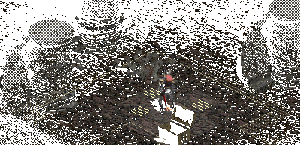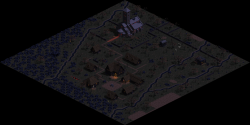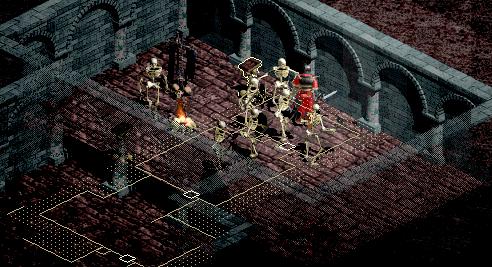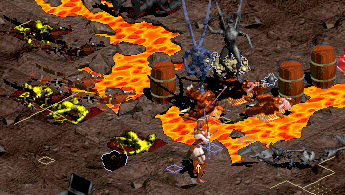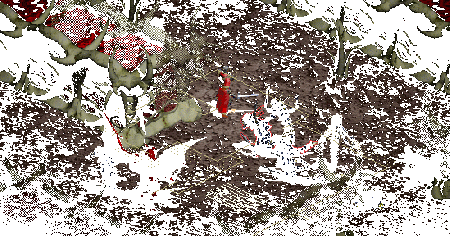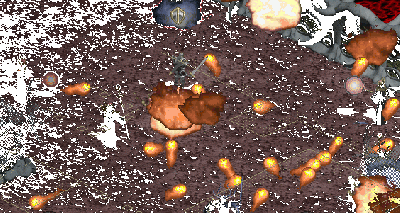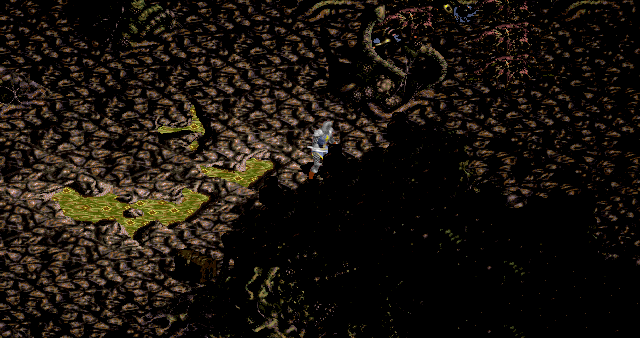Diablo Levels
There are 16 dungeon levels in Diablo, with another 8 added in Hellfire. The levels are divided into groups of four, with a totally new style of artwork and level layout beginning with each new group. Each group of levels has a different feel and they play differently, based on the layout, the size of rooms, the narrow (or not) doorways, and the monsters found within them.
The official names for the sets of levels in Diablo are the Dungeon, Catacombs, Caves, and Hell. The "Dungeon" is often called the "Church", "Cathedral", or "Monastery" by players, as it is directly below the desecrated building.
Contents
Diablo Levels[edit]
There are 16 levels in Diablo. Shortcuts from town that descend directly to level 5, 9, and 13 become available to characters who have reached those stages. These shortcuts can be entered directly in multiplayer mode on Nightmare and Hell difficulty, and on NM and Hell in single player as well, in Hellfire. Otherwise, players must first use the shortcuts to return to town before they can be used to enter the dungeon.
All regular dungeon levels are randomly-generated in Diablo, with the partial exception of level 16, which is only semi-random, since the same elements are found in each of the four corners. The various smaller sublevels, entered for single player-only quests, are not random in their layouts. Randomization sometimes results in odd effects; the stairs might be found right beside each other, for instance.
Tristram[edit]
The town of Tristram is the first level in the game, and one that players must return to in order to buy and sell items, and replenish their potion stocks. All of the NPCs are found in Tristram, and some of them must be spoken to in order to receive quests and quest rewards. There are stairways down to all the levels in the dungeon from town, though the stairs down to the deeper dungeons do not appear until characters reach various minimum level requirements.
Tristram always has the same layout in Diablo and Hellfire; it's not random at all. There are a few changes in Hellfire, with some added NPCs, as well as the bridge below town that leads to the Hive, and the altered graveyard with the new sepulcher that conceals the entrance to the Crypt.
Click the thumbnail to see an awesome, enormous overhead view of Tristram, composed by piecing together hundreds of individual screenshots.
Dungeon[edit]
- The sanctity of this place has been fouled.
The uppermost four levels are called the "Dungeon" in-game when you point the mouse at the front door of the Cathedral, but this may be a holdover of the use of the term "dungeon" for any fantasy adventure area. Most players often call this the "Cathedral", "Church", or "Monastery", as it is directly below the desecrated building.
These levels are marked by numerous large square rooms connected by long hallways lined with pillars, and lots of smaller side rooms behind closed doors, often filled by shrines or small libraries. There is very little wasted space on these maps; few internal areas are not filled with accessible rooms, so these levels feel larger and longer than some of the later areas.
The monster variety consists of low level animals such as Fallen Ones and scavengers, while undead monsters are particularly abound. Few monsters here possess any elemental attacks, although ranged attacking skeleton archers are very common. The dungeon levels are fairly easy for novice players to clear through.
Catacombs[edit]
- The smell of death surrounds me.
Levels 5-8 are called the Catacombs, or abbreviated to "the Cats." These dark, gray and black levels are maze-like, winding through long, narrow corridors and frequently bottle-necking at single width doorways. The cats are filled with numerous small chambers, most of which boast libraries, shrines, goat shrines, or skeletal tomes. These small rooms are usually packed full of monsters, and many players enjoy leveling up in the cats since those chambers are experience honeypots.
Most characters find these levels not too difficult, since all of the narrow passages and doorways make it easy to take on monsters one at a time. There are few magical attacks to worry about here, so resistance is still largely optional. Ranged attackers are fairly common though, with skeletal archers and goatmen archers quite common, and acid spitters (magic damage) as well, so use caution. Avoiding arrows and running down archers isn't tough, with all the corners and small rooms to restrict their mobility.
Caves[edit]
- It's hot down here.
Levels 9-12 are known as the Caves. The Caves are much more difficult than the Catacombs for most characters, with wide open areas and no long narrow spots to funnel monsters through. There are some gates along the low fences, but the ranged attackers will fire over them, and many monsters will pathfind around some cluster of rock when the gate is blocked, coming at you from behind.
There are numerous streams of lava throughout the Caves, and despite the fact that they're easily narrow enough to step over, these act as impermeable barriers to monster or character movement. They do not stop any sort of ranged attack though, and in some places diagonal melee attacks can be carried out as well. Characters with ranged attacks, Rogues and Sorcerers primarily, can often use the lava rivers to trap enemy monsters and pick them off from safety.
The Caves can be hard to see in, since the outcroppings of rock do not go transparent when you walk behind them. Items dropped behind walls can be quite hard to find, and it's tough to target monsters or barrels at times.
Somewhere on level 9 is a slain hero that will drop a class specific magic item.
Player (after interacting with the Slain Hero)
- Rest in peace, my friend.
Hell[edit]
- I must be getting close.
The levels from 13-16 are referred to as Hell, though Diablo II makes it clear that this is merely a warped manifestation and not the real thing itself. The Caves are actually more like the classical Christian conception of Hell, with rocks and lava and flame; the "Hell" levels in Diablo are very clean and sterile, with walls and stairs seemingly formed from bones, and what looks like lakes of blood behind the walls on every side.
Most map layouts of the levels in Hell are divided into quadrants, with long walls along the middle of the level and four large rooms in each corner. There are exceptions, and some layouts are practically honeycombs, but the majority of areas of Hell are fairly wide open and very conducive to ranged attacks. Rogues can turn these areas into a sort of bowling alley, firing in straight lines well off the visible screen and listening for the sound of their arrows hitting. Sorcerers are very happy in Hell also, with good firing lines for their spells and long, straight stretches of level to retreat to, while still firing at the advancing enemies.
Hell Monster To/Hit Bonus[edit]
Physical damage monsters on the lower levels of Hell have a bonus to/hit that makes them more likely to hit characters, irrespective of their defense (though hits may still be blocked). These bonus hits (more accurately described as special penalties to player defense) mean that monsters on these levels never have a to/hit lower than:
- Dlvl 14: 20%
- Dlvl 15: 25%
- Dlvl 16: 30%
They may have much higher to/hits than these; such as on a lightly-armored Sorcerer. But their to/hit is never lower than this. (There are no physical damage ranged attackers in Hell. This property is not applied to magical attacks, such as Bloodstars, Flash, or Fireballs, which are calculated differently than melee strikes.)
Level 16[edit]
Level 16 always has the same layout and monsters (Blood Knights and Advocates) each game, with about half of the monsters in pre-set positions. Others are spawned in random locations each game, though. There are no chests, barrels, or cauldrons found on level 16. Since there are always only two types of monsters on this level, and since Advocates are triple immune on Hell difficulty, all characters can benefit from special tactics on this level.
One of the simplest and most useful is to run through the open areas of this level, especially the northern quarter, activating all of the Blood Knights and training them out to some area that's already clear of Advocates. This makes it easier to kill the Knights (with fire or melee) without having to dodge fireballs at the same time, and makes it easier to deal with the Advocates without having the tanking Knights slowing you down.
This same sort of Fireball gauntlet can be run in other places on the map, including the western quarter (once the switch is thrown to open the walls). It's much easier to clear the Advocates out of that + shaped box once the Knights are disposed of.
Hellfire Levels[edit]
The Hellfire expansion pack added eight more levels. They have new graphics, but use the same level formation tools (random map generation) as earlier levels did in Diablo.
Nest/Hive[edit]
The Hive, as it's usually called, or the Nest, as it's officially named, uses the level generation of the Caves, but changes the graphics from rock and lava to a vaguely sci-fi, Aliens-styled insect hive. Some of the monsters are themed to that insect style; giant spiders and scorpions and such, but many others seem fairly random in design and function.
The Hive is balanced to be equivalent to the Caves in difficulty, but most players find it somewhat easier. Easier to zoom through on the way down to level 4 on your mission to retrieve the Cathedral Map, usually, since this area is hands down the least popular in the game.
There are no random bosses in the Hive, and no quests, other than two versions of the same item-retrieval task. There aren't any shrines or pools or library rooms either, making the four levels something of a boring, unrelieved slog.
Crypt[edit]
- This is a place of great power.
The Crypt is meant to be equivalent to Hell in difficulty, and the monsters there, all newly added in Hellfire, can be quite nasty. The area is easier than Hell, at least on normal difficulty, since all of the doorways provide easy choke points to bottleneck the monster mobs. It gets harder on Nightmare and Hell though, especially for Sorcerers, since the monsters have much more varied resistances and immunities, and quite a few of the beasties are immune to fire and lightning, forcing Sorcerers to use the much weaker magical damage spells, or else stone curse and a melee weapon. The smaller rooms and areas are a pain for Sorcerers too, keeping their spells from hitting enemies at long distance.
The monsters in the Crypt are better designed and themed than the grab bag of enemies in the Hive, and there is a nice mixture of animals, demons, and undead, something not seen in the Hell levels (which are almost entirely demons, with one or two animals and no undead).
The Crypt reuses the tile set from the Church, but since there are no shrines or libraries, most of those small rooms are boring and entirely empty; of shrines and books, as well as monsters. Like the Hive, the Crypt holds zero monster bosses, other than Na-Krul on level 4. It's not known why the Sierra designers didn't include any bosses in the levels they added, but it goes a long way towards explaining why most players find those levels much less fun than the original 16.
| Diablo I - Hellfire [e]
Basics Quests Skills Monsters |
|---|
| Diablo I Basics [e] | ||||
|---|---|---|---|---|
|
Uniques |
Base Items |
Miscellaneous Items |
Characters |
Other Essentials |
| Quest General Info - Quest Items[e] | ||||
|---|---|---|---|---|
|
Church |
Catacombs |
Caves |
Hell |
Hellfire Quests |
| Diablo I Spells | Hellfire Spells [e] | ||||
|---|---|---|---|---|---|
|
• Apocalypse |
• Firebolt |
• Heal Other |
• Nova |
• Berserk |
• Mana |
